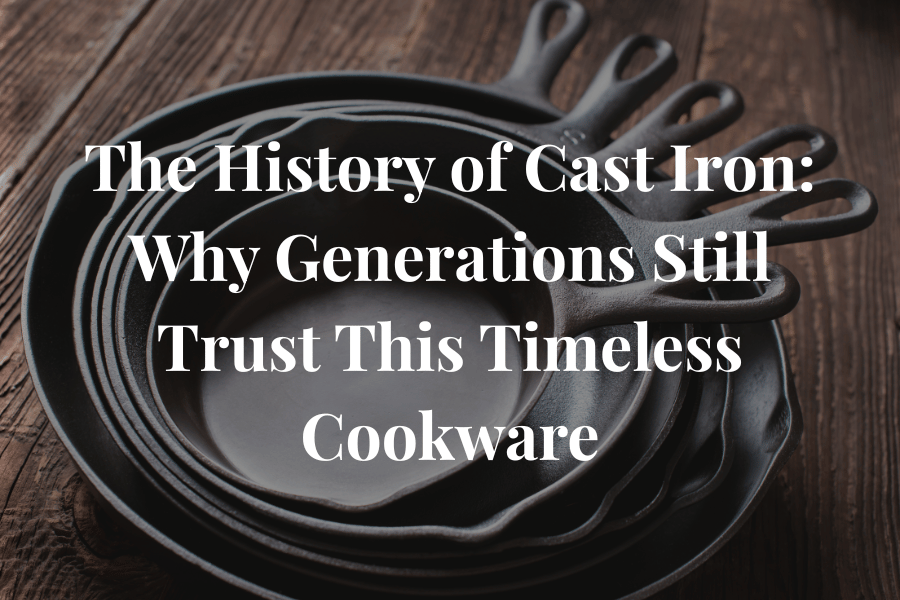The History of Cast Iron: Why Generations Still Trust This Timeless Cookware

From pioneer cabins to modern home kitchens, cast iron cookware has stood the test of time. While trends in kitchen tools come and go, cast iron has remained a staple. But why does it continue to earn a place on the stovetop, decade after decade?
This article explores the deep history of cast iron cookware, why it became a household essential, and what makes it one of the most beloved traditional cookware materials even today.
The Origins of Cast Iron Cookware
The roots of cast iron cookware trace back to ancienthina, where cast iron tools and vessels were first produced around the 5th century BCE. These early uses were primarily industrial, but as casting techniques evolved, cookware emerged as a vital application.
By the 15th century, Europe had adopted cast iron casting, and by the 1700s, American colonies were using it for daily cooking. Large, heavy Dutch ovens became a centerpiece in open-hearth kitchens, known for their heat retention and reliability.
The process of sand casting—pouring molten iron into molds—made cookware accessible and affordable, further boosting its popularity across different cultures and classes.
Cast Iron in Early American Homes
In the 18th and 19th centuries, cast iron cookware became a symbol of practicality in American households. Skillets and Dutch ovens were prized for their durability, and their ability to handle everything from hearth-cooked stews to skillet-seared cornbread.
Major U.S. manufacturers like Griswold and Wagner Ware rose to prominence in the late 1800s, producing finely milled cast iron pans that are still collected and used today. These early pieces were often passed down as family heirlooms, gaining value with age and use.
Cast iron wasn’t just cookware—it was part of the American culinary identity.
Why Cast Iron Never Went Out of Style
Despite the rise of aluminum, nonstick, and stainless steel cookware, cast iron remains a favorite. Here’s why:
-
Unmatched heat retention: Once hot, cast iron holds steady, making it ideal for searing, frying, and baking.
-
Versatility: Safe for stovetop, oven, grill, or campfire.
-
Longevity: With proper care, cast iron cookware lasts generations.
-
Naturally nonstick: With seasoning, the surface becomes smooth and easy to cook on without synthetic coatings.
-
Value: It performs as well—or better—than high-end cookware, often at a fraction of the cost.
As people move toward traditional, minimal, and sustainable kitchen tools, cast iron fits that vision perfectly.
The Return of Traditional Cookware
In recent years, there’s been a renewed appreciation for slower cooking methods, hands-on meal prep, and heirloom kitchen tools. Cast iron sits at the heart of this movement.
Modern home cooks are once again investing in long-lasting, no-nonsense cookware—free from chemicals, coatings, and waste. That’s why cast iron, once considered old-fashioned, is now a hallmark of intentional, quality-driven kitchens.
What Cast Iron Represents Today
Cast iron cookware isn’t just about utility—it represents craftsmanship, simplicity, and resilience. In a culture of quick fixes and disposable goods, cast iron reminds us that some things get better with time.
Whether it’s a skillet handed down through your family or a brand-new pan being seasoned for the first time, cast iron carries stories. Each use deepens the patina and strengthens its legacy.
Final Thoughts
Understanding the history of cast iron cookware helps us appreciate its continued relevance. It’s not a trend—it’s a time-tested tool that’s earned its place in kitchens around the world.
Whether you're a beginner or a seasoned cast iron cook, maintaining the right habits and using the proper cleaning products will ensure your cookware stays in top condition for years to come.
No comments






0 comments